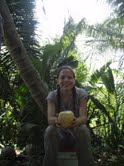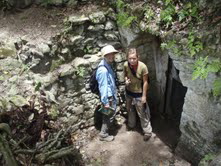Grant Gives Insight into Mayan Culture
The blogosphere is already in atwitter and at least one Hollywood blockbuster is in the works, cashing in on the current pop culture prediction that the Mayan calendar calls for the world to end in December 2012.
 But Jessica Perren of Mabelvale, a UALR senior double majoring in anthropology and art, is participating in research among the ruins of an ancient city in Belize this summer that suggests the Mayan Doomsday Calendar myth is just that.
But Jessica Perren of Mabelvale, a UALR senior double majoring in anthropology and art, is participating in research among the ruins of an ancient city in Belize this summer that suggests the Mayan Doomsday Calendar myth is just that.
She and the research team she is working with are uncovering evidence that hints Mayans believed humankind could enjoy an infinite existence. They are uncovering knowledge in the Mayan city of El Pilar that potentially could help supply the world with limitless food sources, save the forests and protect endangered species.
“The traditional methods of gardening called ‘forest gardening’ that our team has found evident in the archaeology and ecology at the El Pilar site may provide insight for contemporary solutions to food security and sustainable farming,” she said. “The archaeological research shows the complex interrelationships between cultural systems and their environment.”
Perren received a UALR Anthropology Fellowship to study with the Belize River Archaeological Settlement Survey (BRASS), a research team founded in the early 1980s by Dr. Anabel Ford, an archeology professor from the University of California, Santa Barbara.
The international group works with modern forest gardeners to preserve the Maya Forest in El Pilar and its conservation secrets. Preservation is a key focus of the group since rampant deforestation has compromised Mesoamerica’s biodiversity. Eighty percent of the area’s original habitat has been cleared or severely modified.
The area is a rich locale for researchers because of the human touch found in its ecology. Ford, field director of the expedition, said 90 percent of the plants in the Maya Forest in El Pilar are useful to humans, an indication of considerable human influence.
First occupied around 1000 B.C., El Pilar sits on the Belize River on the border of Guatemala and Belize in Mesoamerica, a region of Mexico and Central America. It is the largest Mayan city in the region, with 25 plazas spanning more than 100 acres. “El pilar,” is Spanish for “watering basin.”
The practice of forest gardening, which involves a planting cycle, or milpa, can save forests and wildlife while providing a large population with food for decades. Although actively farmed, forest gardens still retain the feral beauty so indicative of nature.
“Dr. Ford contends that we often think of the rainforest as untouched by humans,” Perren said. “In reality, Dr. Ford says, it can be understood as the garden of the ancient Maya, the product of millennia of management by forest gardeners who cultivated the cycle of milpa.”
The milpa cycle evolves over 20 years and has four main stages. In the first stage, farmers clear and burn a section of the forest. Next, they plant maize, beans and squash and cultivate these crops under full sun for two to three years. Farmers encourage the weedier plants that grow beneath the maize to flourish, because these lower plants attract pests away from the garden, enrich the soil and trap moisture in the ground.
Farmers plant quick-yielding trees — bananas, plantains and papaya — that will bear fruit in a year’s time in the second stage. Slower yielding trees such as
avocado, mango and citrus are planted among the vegetables and will be ready for harvest in about five years. An ordinary garden is transforming in to a lush forest.
As the fruit trees mature and begin to produce, the third stage begins. The trees’ leaves create a thick canopy overhead that blocks sunrays and stunts undergrowth. The original crops of maize, beans and squash can no longer grow in such heavy shade. Forest gardeners then plant hardwoods such as cedar and mahogany that will take decades to mature.
The final stage of milpa is forest regeneration. Hardwoods tower over the fruit trees creating a higher, dense canopy, and the forest garden looks much like it did 20 years before the initial clearing. After the hardwoods mature, the forest gardeners harvest lumber for personal use or for sale. With the field cleared and ready for burning and replanting, the cycle of milpa starts all over again.
Despite their best conservation efforts, the Mayans overextended their human resources. In a 2009 interview with American Archaeology, Ford said Mayan leaders reassigned agricultural labor to the city’s infrastructure. The split labor force could not successfully maintain both the produce and structure systems for such a large, growing population, a problem that contributed to the end of El Pilar’s 1,500-year civilization.
In addition to her archeology work in Belize, Perren did work on a local educational project, working with the non-profit Maya Forest Garden Network and its Santa Familia primary school garden project.
“We want to create a map of the forest garden for the children and a booklet that identifies the names of all the plants at the garden and their uses in Maya, Spanish, Creole, English, and even the scientific names,” she said.
Reflecting on her choice of careers, Perren said she chose anthropology because of its holistic value.
“Anthropology draws from subfields such as the physical, biological, linguistic, archeological, and cultural,” she said. “All of these various pieces help us understand what it means to be human.”